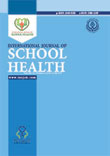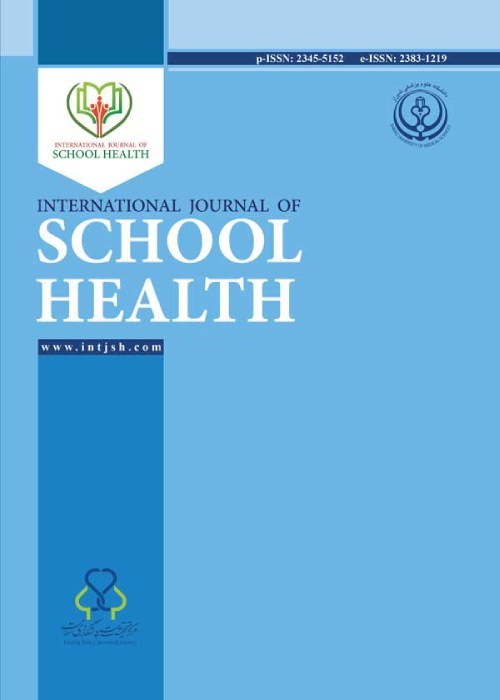فهرست مطالب

International Journal of School Health
Volume:4 Issue: 3, Summer 2017
- تاریخ انتشار: 1396/04/19
- تعداد عناوین: 7
-
-
Page 1BackgroundBorderline personality (BP) is a serious mental condition in clinical practice which is marked by aggression and is shown to be affected by traumatic life events.ObjectivesThis study aimed to determine the relationship between early trauma and aggressive traits as predictive factors of borderline personality features (BPF) in high school students.MethodsThree hundred and eleven students with mean age of 16.66 were recruited via multi stage random sampling. All the participants were asked to complete borderline personality features scale for children, early trauma inventory, and buss-perry aggression questionnaire. Analyzing data was done using canonical correlation.ResultsThe results indicated that BPF is predicted by early trauma and aggression traits.ConclusionsIn general, the findings showed that early trauma, physical aggression, verbal aggression, anger, and hostility can predict BPF and explain a considerable variance of survival index.Keywords: Borderline Personality Disorder, Trauma, Aggression, Students
-
Effects of a School-Based Intervention on BMI z-Scores and Fitness Parameters in Mississippi Delta ChildrenPage 2Background And ObjectivesAlthough Mississippi is making modest progress in childhood obesity prevention and reduction; most of the recent benefits are seen in white children. The purpose of Eating good and moving like we should (EGMLWS), a school-based intervention was to create a successful program to prevent and reduce childhood obesity in the Mississippi Delta, among mostly African American students.MethodsThe program worked with third grades in 7 schools. It provided curricula, started school gardens, and school menu consultation. BMI s-scores were calculated and Fitnessgram parameters were measured, including 20-m progressive aerobic cardiovascular endurance run (PACER) and back-saver sit-and-reach (BSSR). Demographic and beginning heights and weights were analyzed using descriptive statistics. Pre- and post-intervention BMI z-scores and Fitnessgram scores for each school were compared using paired t-test.ResultsMean BMI z-scores were significantly lowered in 2 schools, not changed in 4 schools and increased in 2, although all schools had individuals with decreased BMI z-scores. PACER scores increased in 5 of 7 schools while sit-and-reach left and right scores increased in 5 and 6 of the 7 schools, respectively. All schools improved in at least one PACER measure, and 3 schools improved across all measures.ConclusionsAfter one school year in EGMLWS, north MS Delta third graders improved in both the PACER and sit-and-reach components of Fitnessgram assessment. BMI z-scores were lowered in 2 schools and remained the same in 4 schools. Also, BMI-z-scores did not rise over all schools and there was some lowering of BMI z-scores in every school, which was encouragement that school-based interventions can favorably impact BMI and fitness in primarily African American populations.Keywords: School, Based Intervention, Exercise, Pediatrics, Obesity, Physical Activity, Fitnessgram Assessment
-
Page 3BackgroundAchievement motivation is among the structures that have been attracting the attention of many researchers in the field of psychology and education.ObjectivesThe present study aimed at investigating the mediating role of emotional intelligence in relationship between family communication patterns and achievement motivation.MethodsIn this correlational study, 291 high school students (all male) were selected from Shiraz city using the random multistage cluster sampling method. To collect data, the scale of family communication patterns, emotional intelligence and achievement motivation questionnaires were used. The research conceptual model was analyzed and assessed using the simultaneous sequential regression method and the steps proposed by Baron and Kenny. All analyses were performed using the SPSS software version 22.ResultsThe results showed that family conversation orientation was a positive predictor of achievement motivation (PConclusionsAccording to the results of this study, increasing of conversation orientation and emotional intelligence and decreasing of conformity orientation are accompanied by increasing high school students achievement motivation.Keywords: Achievement Motivation, Family Communication Patterns, Conversation Orientation, Conformity Orientation, Emotional Intelligence
-
Page 4BackgroundA diet rich in fruits and vegetables can lower the risk of cancer, cardiovascular diseases and strokes. For adolescents, particularly females, eating enough fruits and vegetables is critical. This study intended to explore fruits and vegetables intake among the female adolescents living in the city of Isfahan, Iran.MethodsThis descriptive-analytical study was performed on 331 female students, who were recruited by cluster randomized sampling. A valid self-designed questionnaire was used that covered a set of items on demographic data and amount of fruits and vegetables used by the students. This questionnaire was completed by the students in their classrooms, during school hours.ResultsThe average intake of fruits and vegetables by female adolescents was 3.11 servings per day. In this study, for 10.3% of the female adolescents, the intake of fruits and vegetables was 5 servings or more. For female adolescents, there was a statistically significant correlation between the consumption of fruits and vegetables and the level of education of their parents. It was also found that the intake of fruits and vegetables was positively correlated with the households income.ConclusionsGiven the standard values reported for the intake of fruits and vegetables, the findings of this study revealed that the female adolescents participating in this research were susceptible to the health risks resulting from insufficient consumption of fruits and vegetables.Keywords: Fruits Intake, Vegetables Intake, Female Adolescents
-
Page 5BackgroundAlthough undernutrition in children is widely recognized as a major health problem in Tanzania, region-specific prevalence data remain scarce. The objective of the present study was to determine the prevalence of stunting and thinness among primary-school-aged children in a village in the Arusha region in Tanzania, with the aim of developing a targeted nutritional support program.MethodsIn the present school-based cross-sectional study, anthropometric measurements were obtained for all children (n = 1,379) who attended Baraa primary school in the Baraa village located at the transition between a rural and urban area in the Arusha region. The data were compared with the world health organization (WHO) 2007 growth reference data for individuals between the ages of 5 to 19. Continuous variables were compared using the t-test, while categorical variables were compared using Pearsons chi-square test. Spearmans correlation and χ2 for trend were used to compare the trend of continuous and categorical variables, respectively.ResultsBasic anthropometric values of the study participants were significantly lower than those of the reference population. The mean values of z-scores significantly differed from zero. No gender differences in the prevalence of stunting and thinness were found. Three hundred and twenty-six children (23.7%) suffered from at least one form of undernutrition: 225 (16.3%) were stunted while 156 (11.3%) were thin. The prevalence of both stunting and thinness was at its lowest in the youngest children (5 - 9 years) and highest in the oldest children (14 - 19 years). Furthermore, 54 (16.5%) of the undernourished children suffered from multiple forms of undernutrition.ConclusionsUndernutrition remains prevalent among primary-school-aged children in the Arusha region, Tanzania. Moreover, a high proportion of children suffer from a combination of different forms of undernutrition, with an increase in the prevalence of undernutrition with age.Keywords: Prevalence, Anthropometry, School, Aged Children, Undernutrition, Tanzania
-
Page 6BackgroundDepression causes poor academic performance, substance abuse, antisocial behavior, school avoidance, and running away from home in adolescents. Due to the high prevalence of depression in adolescents, reliability, and validity of this questionnaire in this age group is of special importance. Symptoms of depression in children and adolescents are different from their indications in adults.ObjectivesThe current study aimed at assessing reliability and validity of the Beck depression inventory- second edition (BDI- II) in high school students in Shiraz, Iran.MethodsA total of 1150 high school students from Shiraz were selected to assess the validity and a sum of 128 students from the same city were tested to measure the reliability of the study. Concurrent validity and factor analysis were used to assess validity. Concurrent validity was assessed using Beck anxiety inventory and depression anxiety stress scale (DASS)-21. Factor analysis was computed using varimax rotation method. To assess reliability, test-retest and Cronbachs alpha were adopted.ResultsCorrelation coefficients for the concurrent validity of this inventory with Beck anxiety inventory and DASS-21 were 0.45 and 0.55, respectively. The results of factor analysis with varimax rotation method showed 4 factors that predicted 43.69% of the total variance of the test. The reliability and correlation coefficients 0.55 and 0.83 were obtained from test-retest and Cronbachs alpha methods, respectively.ConclusionsBased on the results of the current study, researchers can use BDI- II in psychological research and clinical use for high school students in Shiraz.Keywords: Beck Depression Inventory, II, Validity, Reliability, High School Students
-
Page 7BackgroundCurrent concerns around obesity, physical inactivity, eating disorders and their associated health consequences sustains the need for understanding body image and disordered eating in adolescence.ObjectivesThe study explored how subjective appraisals of health, familial support, wellbeing and weight are associated with body image and dieting attempts in adolescents.MethodsThe study analysed data from a population-representative UK adolescent sample of 3,684 adolescents (aged between 11 and 16) from Understanding Society. Gender-stratified hierarchical and logistic regressions modelled the relationships between the adolescents subjective appraisals of self (health, familial support, wellbeing and weight) and their body image and dieting attempts respectively.ResultsSubjective appraisal of being overweight was the strongest and most consistent predictor of poorer body image (Bs = 1.17 to 1.19, PConclusionsThese highlight the importance of incorporating education components addressing wellbeing and family support into current adolescent public health programmes looking to mitigate risks of developing unhealthy weight control behaviours.Keywords: Body Image, Dieting, Weight Loss, Adolescent, Subjective Appraisals, Wellbeing


